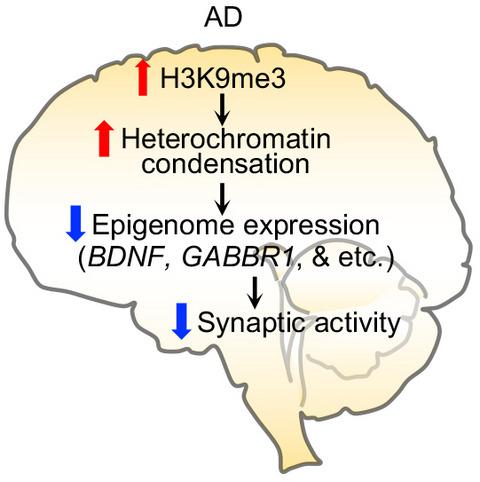当前位置:
X-MOL 学术
›
Aging Cell
›
论文详情
Our official English website, www.x-mol.net, welcomes your
feedback! (Note: you will need to create a separate account there.)
Epigenome signatures landscaped by histone H3K9me3 are associated with the synaptic dysfunction in Alzheimer's disease.
Aging Cell ( IF 8.0 ) Pub Date : 2020-05-17 , DOI: 10.1111/acel.13153 Min Young Lee 1 , Junghee Lee 2, 3 , Seung Jae Hyeon 4 , Hyesun Cho 5 , Yu Jin Hwang 4 , Jong-Yeon Shin 5 , Ann C McKee 2, 3, 6 , Neil W Kowall 2, 3 , Jong-Il Kim 5 , Thor D Stein 2, 3 , Daehee Hwang 7 , Hoon Ryu 2, 3, 4
Aging Cell ( IF 8.0 ) Pub Date : 2020-05-17 , DOI: 10.1111/acel.13153 Min Young Lee 1 , Junghee Lee 2, 3 , Seung Jae Hyeon 4 , Hyesun Cho 5 , Yu Jin Hwang 4 , Jong-Yeon Shin 5 , Ann C McKee 2, 3, 6 , Neil W Kowall 2, 3 , Jong-Il Kim 5 , Thor D Stein 2, 3 , Daehee Hwang 7 , Hoon Ryu 2, 3, 4
Affiliation

|
The pathogenesis of Alzheimer's disease (AD) and the commonest cause of dementia in the elderly remain incompletely understood. Recently, epigenetic modifications have been shown to play a potential role in neurodegeneration, but the specific involvement of epigenetic signatures landscaped by heterochromatin has not been studied in AD. Herein, we discovered that H3K9me3‐mediated heterochromatin condensation is elevated in the cortex of sporadic AD postmortem brains. In order to identify which epigenomes are modulated by heterochromatin, we performed H3K9me3‐chromatin immunoprecipitation (ChIP)‐sequencing and mRNA‐sequencing on postmortem brains from normal subjects and AD patients. The integrated analyses of genome‐wide ChIP‐ and mRNA‐sequencing data identified epigenomes that were highly occupied by H3K9me3 and inversely correlated with their mRNA expression levels in AD. Biological network analysis further revealed H3K9me3‐landscaped epigenomes to be mainly involved in synaptic transmission, neuronal differentiation, and cell motility. Together, our data show that the abnormal heterochromatin remodeling by H3K9me3 leads to down‐regulation of synaptic function‐related genes, suggesting that the epigenetic alteration by H3K9me3 is associated with the synaptic pathology of sporadic AD.
中文翻译:

组蛋白 H3K9me3 修饰的表观基因组特征与阿尔茨海默病的突触功能障碍有关。
阿尔茨海默病 (AD) 的发病机制和老年人痴呆症的最常见原因仍未完全了解。最近,表观遗传修饰已被证明在神经变性中发挥潜在作用,但尚未在 AD 中研究异染色质景观化的表观遗传特征的具体参与。在此,我们发现 H3K9me3 介导的异染色质凝聚在散发性 AD 死后大脑的皮质中升高。为了确定哪些表观基因组受异染色质调节,我们对正常受试者和 AD 患者的死后大脑进行了 H3K9me3 染色质免疫沉淀 (ChIP) 测序和 mRNA 测序。全基因组 ChIP 和 mRNA 测序数据的综合分析确定了表观基因组,这些表观基因组被 H3K9me3 高度占据并且与其在 AD 中的 mRNA 表达水平呈负相关。生物网络分析进一步揭示了 H3K9me3 景观表观基因组主要参与突触传递、神经元分化和细胞运动。总之,我们的数据表明,H3K9me3 引起的异常异染色质重塑导致突触功能相关基因的下调,表明 H3K9me3 引起的表观遗传改变与散发性 AD 的突触病理学有关。
更新日期:2020-05-17
中文翻译:

组蛋白 H3K9me3 修饰的表观基因组特征与阿尔茨海默病的突触功能障碍有关。
阿尔茨海默病 (AD) 的发病机制和老年人痴呆症的最常见原因仍未完全了解。最近,表观遗传修饰已被证明在神经变性中发挥潜在作用,但尚未在 AD 中研究异染色质景观化的表观遗传特征的具体参与。在此,我们发现 H3K9me3 介导的异染色质凝聚在散发性 AD 死后大脑的皮质中升高。为了确定哪些表观基因组受异染色质调节,我们对正常受试者和 AD 患者的死后大脑进行了 H3K9me3 染色质免疫沉淀 (ChIP) 测序和 mRNA 测序。全基因组 ChIP 和 mRNA 测序数据的综合分析确定了表观基因组,这些表观基因组被 H3K9me3 高度占据并且与其在 AD 中的 mRNA 表达水平呈负相关。生物网络分析进一步揭示了 H3K9me3 景观表观基因组主要参与突触传递、神经元分化和细胞运动。总之,我们的数据表明,H3K9me3 引起的异常异染色质重塑导致突触功能相关基因的下调,表明 H3K9me3 引起的表观遗传改变与散发性 AD 的突触病理学有关。











































 京公网安备 11010802027423号
京公网安备 11010802027423号